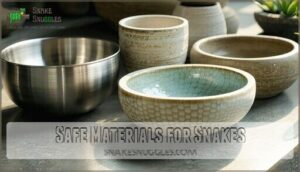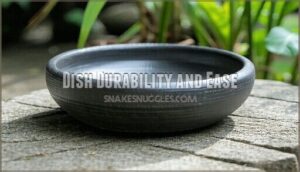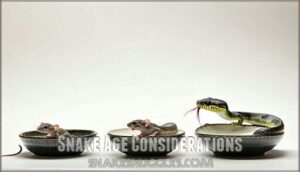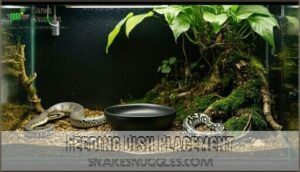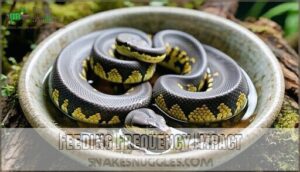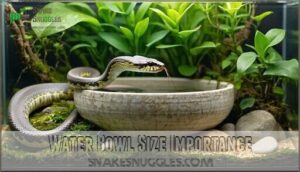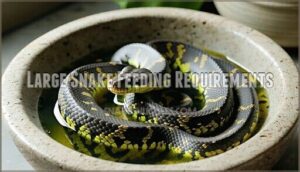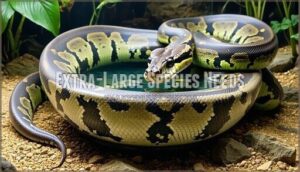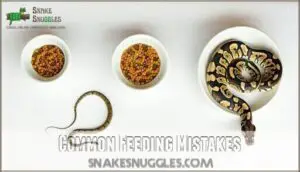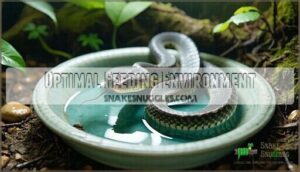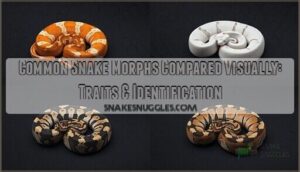This site is supported by our readers. We may earn a commission, at no cost to you, if you purchase through links.
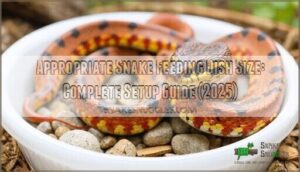 You’ll need to match your snake’s feeding dish size to the prey you’re offering.
You’ll need to match your snake’s feeding dish size to the prey you’re offering.
Choose a dish that’s slightly wider than your snake’s thickest part, typically around the middle section.
This guarantees your snake can comfortably position itself while eating without struggling in cramped quarters.
The dish should be shallow enough for easy access but deep enough to prevent prey from escaping.
For most snakes, a dish that’s 1.5 times the snake’s width works perfectly.
Don’t forget that different snake species have unique feeding behaviors that affect dish requirements.
Getting the appropriate snake feeding dish size right makes feeding time less stressful for both you and your scaly friend, but there’s much more to reflect on beyond just measurements.
It’s about creating a comfortable and safe environment, which is crucial for the well-being of your pet, and understanding that feeding time can be a critical moment in your interaction with your snake.
Table Of Contents
- Key Takeaways
- Snake Feeding Dish Size
- Feeding Dish Materials
- Snake Age Considerations
- Species Specific Feeding
- Feeding Dish Placement
- Feeding Frequency Impact
- Water Bowl Size Importance
- Feeding Dish Size Guidelines
- Common Feeding Mistakes
- Optimal Feeding Environment
- Frequently Asked Questions (FAQs)
- How big should my snakes water dish be?
- How big should snake food be?
- How big of a water bowl does a corn snake need?
- Can multiple snakes share the same feeding dish?
- Should feeding dishes be heated or temperature controlled?
- How often should you replace feeding dishes?
- Are ceramic dishes better than plastic ones?
- Should feeding dishes have textured or smooth surfaces?
- Conclusion
Key Takeaways
- Measure your snake’s width at its thickest point – You’ll need a dish that’s 1.5 times wider than your snake’s midsection to ensure comfortable feeding without cramping or stress.
- Choose the right depth for safety – Keep dishes shallow (1-2 inches) for most snakes to prevent drowning risks while still allowing easy prey access and preventing escapes.
- Select safe, durable materials – You’ll want ceramic, glass, or food-grade stainless steel dishes that won’t tip over, harbor bacteria, or leach harmful chemicals into your snake’s food.
- Adjust dish size as your snake grows – Hatchlings need 4-6 inch dishes, while adults require 9-10 inches or larger, so you’ll need to upgrade regularly to match your snake’s changing body proportions.
Snake Feeding Dish Size
You’ll need to match your feeding dish size to your snake’s body width for safe, stress-free feeding sessions.
Getting the right dimensions prevents prey escape while ensuring your snake can access food comfortably without struggling or creating mess, which is crucial for stress-free feeding.
Right dish size equals stress-free feeding and prevents messy prey escapes.
Measuring Snake Width
Accurately measuring your snake’s width is essential for selecting the right snake feeding dish size.
You’ll need to measure the widest part of your snake’s body, typically at the midsection, to determine appropriate dish size for safe feeding.
Here’s how to measure your snake’s width properly:
- Use flexible measuring tools – String or soft tape measure works best around your snake’s thickest body section
- Focus on the midsection – Avoid the head and tail areas; measure where your snake’s body appears widest
- Consider growth stage impact – Young snakes need frequent remeasuring as they grow rapidly
- Account for species variation – Different snake species have varying body shapes that affect measuring techniques
When measuring, remember that species affect measurements, particularly when using soft-tape.
Dish Width Requirements
Your snake feeding dish should be 1-1.5 times your snake’s width for comfortable feeding.
Match your feeding dish to 1-1.5 times your snake’s width for stress-free, comfortable feeding sessions.
This appropriate dish size prevents spillage while allowing easy prey access. Match the dish to your snake’s body size—too narrow causes stress, while oversized bowls make portion control tricky.
Consider reptile-safe materials to guarantee your snake’s health and safety.
Getting the snake feeding dish size right guarantees your pet feeds naturally without struggling or escaping prey.
Depth and Edge Considerations
While width matters, dish depth and edge height directly affect your snake’s feeding safety.
Dish depth is crucial as shallow dishes reduce drowning risk for hatchlings, while proper edge height prevents tipping and guarantees access ease.
Most snakes need 1-1.5 inch depth for comfortable feeding, and low-profile, smooth edges work best – they’re escapeproof without creating barriers.
Match dish size and shape to your snake size for ideal snake feeding safety.
Feeding Dish Materials
You’ll want to choose feeding dish materials that won’t harm your snake if accidentally ingested during feeding time.
Ceramic, glass, and food-grade stainless steel dishes offer the best combination of safety, durability, and easy cleaning that busy snake owners need.
Safe Materials for Snakes
Four essential materials create the safest snake feeding dish environment.
Food-grade Non-Toxic Plastics and resin bowls won’t leach harmful chemicals into your reptile food bowl.
Ceramic Glazes provide heavy, tip-resistant options, while Stainless Steel resists bacteria buildup.
For reptiles, consider using safe feeding containers.
Natural Materials like sealed stone work too, and it’s crucial to choose nonporous snake dish surfaces that resist Cleaning Agents for ideal snake safety.
Dish Durability and Ease
Building a snake feeding dish that lasts requires smart material choices.
You’ll want something that won’t crack under pressure or become a cleaning nightmare.
Here’s what makes a feeding dish truly durable:
- Material strength – Choose thick ceramic or heavy-duty plastic that won’t chip when your snake gets enthusiastic about dinner
- Tipping resistance – Heavier dish weight prevents messy spills during feeding frenzies
- Cleaning ease – Nonporous surfaces on your reptile food bowl make scrubbing effortless
- Long-term use – Quality construction means your hygienic reptile bowl won’t need replacing every few months
Consider purchasing a durable feeding option for longevity.
Cleaning and Maintenance
Regular dish sanitization keeps your snake healthy and prevents bacterial growth.
You’ll need to remove algae buildup and change water frequently to maintain a hygienic reptile bowl.
Consider using a snake feeding cleaner to help maintain a sanitary environment.
Choose nonporous snake dish materials for easy cleaning and better bacteria control.
Material accessibility matters – smooth surfaces beat textured ones for substrate cleaning and overall maintenance.
Snake Age Considerations
Your snake’s age determines both dish size and feeding approach, since hatchlings need shallow access while adults require larger capacity.
As your snake grows, you’ll need to upgrade dish sizes to match their changing body proportions and feeding requirements.
Hatchling Feeding Dishes
Baby snakes need specialized feeding dishes to prevent drowning and substrate ingestion.
A 3-inch diameter by 2-inch deep dish works perfectly for most hatchlings, providing enough room to coil while maintaining escape prevention.
Small cat bowls or ramekins offer material safety and cleaning ease.
- Dish depth should stay under 2 inches – prevents drowning while allowing easy access
- Choose smooth, non-porous materials – ceramic or plastic bowls resist bacterial buildup
- Place dishes on the cool side – reduces rapid evaporation and overheating risks
Juvenile Feeding Requirements
Juvenile snakes need a feeding schedule every 5-7 days with careful prey size selection matching their widest body point.
Your dish for baby snake should accommodate proper dimensions for age-based feeding while preventing escape.
Growth monitoring guarantees appropriate prey sizing as your snake develops. A reptile dish size guide helps determine correct measurements.
Hydration importance increases during rapid growth phases, requiring adequate water access alongside feeding requirements, emphasizing the need for careful hydration management.
Adult Snake Feeding Needs
Adult snakes need large snake dish options that accommodate their size and prey variety.
Your dish for adult snake should follow a reptile dish size guide with proper dimensions – typically 9-10 inches for medium adults.
Use a snake feeding size chart to prevent obesity prevention issues.
Watch for behavioral changes and regurgitation causes from improper sizing.
Supplementation needs vary by species and feeding frequency.
Species Specific Feeding
Different snake species have unique feeding requirements that affect dish size selection.
Ball pythons need wider, shallower dishes for their stocky build, while colubrids prefer deeper bowls that accommodate their longer, thinner bodies, which is related to their feeding requirements and unique characteristics.
Ball Python Feeding Dishes
Ball pythons need dishes that match their midsection width to prevent prey escape and reduce feeding stress.
Use glass or ceramic materials for dish material safety – they’re easier to clean and won’t harbor bacteria.
Your snake dish should accommodate prey weighing 10% of your ball python’s body weight, and place the snake bowl near a hide for comfort.
Maintain proper water dish size for ball python hydration needs.
Colubrid Feeding Requirements
Colubrid species showcase remarkable diversity in their feeding habits, making your snake dish selection vital for their health. Different colubrid prey types require specific feeding approaches, from corn snake rodents to kingsnake varieties.
Frozen rodents are a safe option for captive snakes.
- Dish width: Match your snake’s thickest body section for proper access
- Feeding schedule specifics: Juveniles need meals every 5-7 days, adults every 7-14 days
- Prey variety: Wild colubrid diets include rodents, birds, eggs, and insects
- Snake size considerations: Growing colubrids consume 10% of body weight weekly
- Common colubrid ailments: Prevent impaction with shallow dishes during snake feeding
Python Feeding Dish Size
You’ll want your python feeding dish to match your snake’s girth perfectly. Choose a snake water dish that’s 1.5 times wider than your python’s thickest section.
Different python species have varying prey size needs, so match your snake feeding bowl accordingly. Heavy ceramic or glass prevents tipping during feeding sessions.
Clean weekly to prevent bacterial buildup. Position strategically for prey escape prevention while allowing natural feeding behaviors.
Feeding Dish Placement
You’ll need to place your snake’s feeding dish strategically to reduce stress and prevent prey escape during feeding sessions.
The right placement guarantees your snake can access food easily while maintaining control over the feeding environment, which is crucial for a successful feeding session with minimal stress.
Reducing Stress and Escape
Placing your feeding dish correctly keeps your snake calm and prevents escapes.
Position secure dishes away from enclosure openings and in quiet areas.
Heavy, tip-resistant dishes won’t shift during feeding, reducing stress.
Create a calm environment with visual barriers like hides.
Your snake water dish placement affects stress levels too.
Proper dish placement supports escapeproof feeding while enabling stress reduction through minimal handling techniques and careful observe behavior practices.
Easy Access for Snakes
Your snake’s feeding dish should sit low enough for comfortable access without creating unnecessary obstacles.
Low-profile edges let your snake approach food naturally, while sturdy bases prevent tipping during feeding sessions.
Proper dish placement reduces stress by allowing easy prey accessibility, and the best snake dish design supports natural feeding behaviors.
Choose snake feeding accessories with shallow sides—your snake shouldn’t struggle to reach its meal, and this design choice helps reduce stress by allowing easy access to food, promoting proper dish placement.
Preventing Prey Escape
While deep dishes might seem practical, they can become escape routes for nimble prey like mice or rats.
Choose an escapeproof dish with smooth surfaces and appropriate dish height—typically 1.5 to 2 inches for most snakes.
A heavy snake dish prevents tipping during feeding sessions, while secure lids aren’t necessary if you monitor closely.
For small snake dish options, prioritize prey immobilization over convenience, ensuring your snake feeding setup minimizes stress and maximizes control.
Feeding Frequency Impact
Your feeding frequency directly impacts the dish size you’ll need, since overfeeding leads to larger prey requirements and potential health issues.
Getting the balance right guarantees your snake stays healthy while preventing waste from oversized dishes or stress from undersized ones, which is crucial for preventing waste.
Overfeeding and Dish Size
Large feeding dishes create obesity risks by encouraging oversized prey selection.
You’ll notice regurgitation signs when meals exceed your snake’s body width by more than 1.5 times.
Weight monitoring becomes essential since heavy snake dishes can lead to dish spillage and prey escape.
Small snake dishes naturally limit portion sizes, preventing dangerous overfeeding patterns in your snake diet routine.
Overfeeding can lead to organ dysfunction issues and is a significant concern for snake owners, making weight monitoring crucial.
Underfeeding and Snake Health
While bigger dishes might seem harmless, you’ll face the opposite problem when your snake doesn’t get enough food.
Underfeeding triggers serious health issues including stunted growth, weight loss, and immune suppression.
Your snake’s body can’t maintain proper functions without adequate nutrition, leading to metabolic bone disease and potential organ failure.
Proper snake feeding guidelines prevent these devastating health consequences, ensuring your snake’s overall health and well-being by providing the necessary nutrients to avoid serious health issues.
Adjusting Feeding Frequency
You’ll need to adjust snake feeding frequency based on several key factors that affect your pet’s appetite and digestion.
Age-based needs vary substantially – hatchlings require weekly meals while adults eat every 10-14 days.
Environmental factors like shedding, appetite loss, and brumation impact feeding schedules.
Monitor for regurgitation issues, which signal overfeeding, and adjust accordingly for your snake’s species diets and activity level.
Water Bowl Size Importance
Water bowls aren’t just about hydration – they’re critical for your snake’s overall health and proper digestion.
You’ll need to size them correctly to prevent spillage while ensuring your snake can access water easily and even soak when needed.
Snake Hydration Needs
Your snake’s hydration needs go beyond just drinking water.
Snake hydration becomes critical during shedding periods when dehydration signs like stuck shed or dull skin appear.
Water quality affects overall health, while humidity effects influence your snake’s comfort.
Proper snake care includes monitoring cleaning snake dish regularly and ensuring your snake dish provides adequate access for both drinking and soaking, which is crucial for maintaining your snake’s overall health.
Water Bowl Depth and Size
Bowl depth affects your snake’s comfort and hydration needs.
Shallow bowls work for most species, while deeper options accommodate larger snakes that enjoy soaking.
Consider your snake’s size and behavior when selecting bowl material for cleaning ease.
- Shallow bowls (1-2 inches): Perfect for smaller snakes and easy cleaning
- Medium depth (2-3 inches): Ideal for adult colubrids and ball pythons
- Deep bowls (3+ inches): Best for large pythons that like soaking
Preventing Water Spillage
Most water bowls tip over when you least expect it, creating soggy substrate nightmares.
Choose a ceramic snake dish with a wide, heavy base for maximum dish stability.
Look for bowls with low edge height and material grip on the bottom.
Placement matters – position your nonporous snake dish away from heating elements.
Proper water depth in plastic snake dishes prevents sloshing during feeding sessions, and using a ceramic snake dish can help with stability.
Feeding Dish Size Guidelines
You’ll need different dish sizes as your snake grows, with specific measurements ensuring safe and comfortable feeding.
Small snakes under 100g require shallow dishes around 5.5" x 5.5" x 1.5", while extra-large species over 1,500g need dishes 13 inches or larger to accommodate their feeding and soaking needs.
Small Snake Feeding Dishes
Small snake owners often underestimate how Dish Material Safety affects their pet’s health. Choosing appropriate feeding dishes prevents Substrate Ingestion Risk while supporting proper nutrition.
- Hatchling Dish Size: Use 4-6 inch diameter dishes for snakes under 200g to prevent stress and substrate contamination
- Shallow Dish Benefits: Select 1.5-inch deep bowls that allow easy access without creating feeding anxiety
- Cleaning Small Dishes: Choose nonporous snake dish materials like ceramic snake dish or quality plastic snake dish options
- reptile feeding accessories: Match snake care supplies to your pet’s specific size requirements for ideal feeding success
Large Snake Feeding Requirements
When you’re dealing with adult colubrids and pythons weighing 500-1,500 grams, you’ll need dishes around 9-10 inches in diameter.
These larger snakes require more substantial prey weight and longer digestion time, making proper snake feeding dish size critical for preventing regurgitation risks.
A well-sized dish accommodates appropriate rodent size while supporting hydration needs and obesity prevention through controlled snake feeding sessions.
Extra-Large Species Needs
Giant snakes require dishes 13 inches or larger to accommodate their massive prey and soaking needs.
Your burma python or reticulated python needs serious dish stability—these powerhouses can topple lightweight bowls during feeding frenzies.
Choose heavy-duty materials for material safety and expect increased cleaning frequency.
Consider space constraints in your enclosure while ensuring proper prey accessibility for your snake species.
Common Feeding Mistakes
Many snake owners make critical feeding mistakes that can harm their pets’ health and well-being.
The three most common errors involve using incorrectly sized feeding dishes, maintaining poor feeding schedules, and offering inappropriate prey sizes that can lead to serious digestive problems, which are critical mistakes.
Incorrect Dish Size
Many keepers underestimate how incorrect snake feeding dish sizes create serious problems.
Too-small containers cause spillage and stress during feeding, while oversized dishes lead to prey escape and food spoilage.
Wrong-sized dishes also increase substrate ingestion risks and make safe swallowing difficult.
Choose your snake container carefully—proper prey size matters for preventing choking hazards during snake feeding sessions.
Inadequate Feeding Frequency
Ignoring your snake’s feeding schedule creates serious health problems that spiral quickly.
Underfeeding causes weight loss, growth stunting, and appetite loss, while overfeeding triggers regurgitation risks and obesity.
Brumation effects naturally reduce appetite seasonally, but consistent inadequate feeding frequency disrupts normal snake diet patterns.
Monitor your snake’s body condition and adjust the snake feeding schedule accordingly for ideal snake health.
Improper Prey Size and Type
Choosing the wrong prey size or type can seriously harm your snake’s health.
Oversized prey causes regurgitation risks and impaction dangers, while undersized meals lead to nutritional deficiencies.
Live prey hazards include injuries from defensive animals.
You’ll need proper prey selection based on your snake’s species – some prefer rodents, others need birds or reptiles.
Vary prey type occasionally for balanced nutrition, ensuring each meal matches your snake’s widest body section to prevent impaction dangers.
Optimal Feeding Environment
You’ll need to maintain proper temperature and humidity levels in your snake’s feeding area to facilitate successful digestion and reduce stress during meals.
Creating a calm, secure environment with appropriate lighting and minimal disturbances helps your snake feel safe enough to eat regularly and maintain healthy feeding behaviors, which is crucial for its overall well-being and digestion.
Temperature and Humidity Control
Beyond selecting the right dish size, you’ll need to maintain proper environmental conditions for successful feeding. Temperature and humidity directly impact your snake’s appetite and digestion.
Your snake enclosure requires specific conditions for successful feeding:
- Temperature Gradient: Maintain 75-85°F with thermostat use for consistent snake temperature
- Humidity Levels: Keep species-appropriate humidity using monitoring tools
- Seasonal Adjustments: Adjust conditions as natural patterns change
- Dish Placement: Position feeding areas within the ideal temperature zone
Proper snake feeding environment setup guarantees your pet’s health and feeding success. Use substrates like coconut fiber to help retain proper moisture.
Reducing Stress and Aggression
A separate enclosure creates a controlled environment that drastically reduces snake feeding stress and defensive strikes.
You’ll monitor feeding better while maintaining a clean habitat that supports natural behavior.
The right feeding dish material in this setup prevents spills and contamination.
Your snake will display relaxed feeding patterns when stress triggers are eliminated through proper isolation.
Creating a Natural Habitat
You can recreate your snake’s natural habitat by carefully selecting Enclosure Enrichment elements that support healthy feeding behaviors.
Your feeding location should include appropriate Natural Substrates and strategic Hiding Spots that reduce stress during meals.
- Position Climbing Branches near the feeding dish for arboreal species
- Use proper feeding dish material that blends with natural substrates
- Adjust Lighting Needs to create day/night cycles affecting appetite
- Match prey size and prey diameter to your snake feeding environment
Frequently Asked Questions (FAQs)
How big should my snakes water dish be?
Most snakes need water dishes 5-2 times wider than their thickest body section. You’ll want shallow dishes for smaller snakes and deeper ones for larger species that enjoy soaking.
How big should snake food be?
Your snake’s food should match the thickest part of its body.
Choose prey that’s roughly the same width as your snake’s midsection, never exceeding 5 times that diameter to prevent choking or regurgitation.
How big of a water bowl does a corn snake need?
Measure twice, buy once! You’ll want a water bowl about 5 times wider than your corn snake’s thickest part.
It should be sturdy, shallow, and big enough to let your snake soak but not tip over.
Can multiple snakes share the same feeding dish?
You shouldn’t share feeding dishes between multiple snakes.
Each snake needs its own dish to prevent disease transmission, reduce stress, and avoid territorial conflicts that could lead to injuries or feeding problems.
Should feeding dishes be heated or temperature controlled?
Most experts agree that heating feeding dishes isn’t necessary – you don’t need temperature control for your snake’s feeding setup.
Room temperature dishes work perfectly fine since snakes regulate their body heat through their environment, not their food bowls, which makes temperature control in the feeding setup unnecessary.
How often should you replace feeding dishes?
Replace your snake’s feeding dishes every 2-3 weeks, or immediately after you spot cracks, scratches, or persistent odors.
Clean dishes thoroughly between uses, but don’t let small wear fool you—bacteria loves hiding in tiny crevices.
Are ceramic dishes better than plastic ones?
Ceramic dishes offer several advantages over plastic for snake feeding.
They’re heavier, preventing tipping during meals, and resist scratches that harbor bacteria.
Plus, they’re easier to sanitize and won’t absorb odors like plastic can.
Should feeding dishes have textured or smooth surfaces?
Smooth sailing starts with the right tools.
Choose smooth surfaces for your snake’s feeding dish.
Textured surfaces can harbor bacteria and complicate cleaning, while smooth ceramics or glass provide easy sanitation and prevent food particles from sticking during meals.
Conclusion
Picture your snake gracefully coiling around its feeding dish, completely relaxed and focused on its meal.
Getting the appropriate snake feeding dish size right transforms this scene from stressful chaos into peaceful dining. You’ve learned that matching dish width to your snake’s measurements, considering species-specific needs, and maintaining proper placement creates the ideal feeding environment.
Remember, a dish that’s 1.5 times your snake’s width provides the perfect balance of comfort and functionality for successful feeding sessions.
- https://www.reptileforums.co.uk/threads/california-kingsnake-water-bowl-size.1294570/
- https://www.snakemuseum.com/169-reptile-bowls-dishes
- https://a-z-animals.com/reviews/best-water-dishes-for-your-lizard/
- https://www.petmd.com/reptile/water-snake-care-sheet
- https://www.reddit.com/r/snakes/comments/1vyn2b/feeding_how_big_of_a_container_do_you_use/

